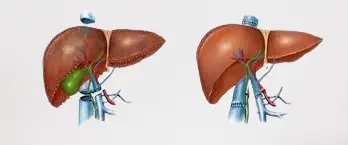
Table of Contents
People with severe liver diseases are saved by liver transplantation, which is the last resort for them. This surgery entails removing a diseased or malfunctioning liver and replacing it with a healthy one taken from a donor’s body.
It is usually performed when other treatments have failed in patients diagnosed with end-stage liver disease, acute hepatic failure or liver cancer.
Improved surgical techniques, immunosuppressive regimes as well as postoperative care have all contributed to better survival rates and improved quality of life among transplant survivors.
Liver Transplantation Availability Though complicated and highly risky, liver transplantation is now available for many patients across the globe.
The procedures involve extensive evaluations of potential recipients, donor matching, and tight postoperative controls that aim to avert symptoms like rejection and infection cases.
In addition to increasing how long they live, it also leads to an enriched state of being that allows them to experience more meaningful lives.
In this exhaustive book on what a person should know about liver transplantation, the author covers its indications, procedure, risks/benefits, and patient experiences before and after surgery.
What is Liver Transplantation?

It involves an operation where another healthy organ replaces the sick or damaged one from the original owner.
It is done only when livers are spoiled beyond repair by end-stage liver disease (ESLD) or hepatocellular necrosis that has rendered them non-functional anymore.
Whether the whole organ or sections of it are implanted, living or deceased donors may be employed.
Because the human liver can regenerate, living-donor partial grafts could involve partial hepatectomy, whereby some part of it is removed from the donor and then grows again.
Liver transplantation requires careful assessment of both the potential recipient and living donor so that compatibility can be achieved during the operation.
Surgical skills acquisition and adequate postoperative care have been proven to be life-saving opportunities for many patients and, as a result, have significantly improved survival rates and quality of life in receivers.
Who is a Candidate for Liver Transplantation?

Usually, liver transplantation patients are those with severe liver diseases that are not responsive to any other intervention.
Cirrhosis, acute hepatic failure and liver cancer, among others, are typical examples. A thorough evaluation has to be done before someone gets enlisted for a transplant, including assessing the severity of hepatic dysfunction and the general health status of the patient.
Consideration in this process is given to factors like age, comorbidities or the presence of other illnesses.
It also allows assessing postoperative care packages, including lifelong immunosuppressive medications required to prevent organ rejection.
It is essential for a medical team comprising various disciplines to consider whether the dangers and advantages of this procedure outweigh each other concerning particular individuals.
What are the Risks and Benefits of Liver Transplantation?

Liver Transplants have high risks but are also highly beneficial. The advantage is that it can give a new lease of life, as this process can address serious illnesses concerning the liver that generally would have killed.
This includes operations allowing them to return to normal activities and improve their health significantly. However, some possible hazards come with this surgery, and there are too many to list here.
Such complications include infection, organ rejection, bleeding and the use of immunosuppressive drugs to prevent the body from attacking its new liver.
The other long-term risks include chronic rejection probability, the likelihood that liver disease will recur in the future and side effects resulting from lifelong taking of medicines.
Despite these risks, though, liver transplantation still counts as an essential option for patients with life-threatening liver conditions, providing hope for significantly improved outcomes.
How is Liver Transplantation Carried Out?

It is such a complex, time-consuming process ranging from removing damaged livers and replacing them where necessary with healthy ones harvested from donors’ bodies. Depending on how complex it is and the patient’s condition, this surgery usually takes 6-12 hours.
The first step involves attaching a patient’s blood vessels carrying blood into their liver onto those supplying blood into the new one, ensuring proper circulation.
The following procedure entails joining bile channels so that any bile it produces goes into the intestines. Then, the surgeon checks for leaks or blockages once they implant the liver and makes all connections.
Once all these attachments are done, no leakages or blockages should exist, according to surgeons.
In order not to suffer significantly after being operated on, the patient shall be taken straight away into a critical care unit where they will be monitored closely while undergoing the healing process.
Patients need close postoperative attention because they may show signs of rejection, infection or other complications. Not only does the procedure’s success depend on its technical aspects, but also on whether the patient can recover and adapt to this new liver.
What is it Like after Liver Transplantation?

After a liver transplant, many things change for good regarding physical and emotional well-being.
There is a need to strictly follow medication regimens, including immunosuppressive ones, to avoid rejecting the new organ.
This will involve regular checks on liver function, detection of signs of rejection and management of medication side effects. In the early stages of recovery, patients may feel tired and need time to regain strength.
However, over time, most people have seen a remarkable improvement in their overall health status and quality of life.
Patients must lead healthy lives that include eating balanced diets, regular exercise and staying away from drinks containing alcohol or using other substances which are toxic to livers.
Proper psychological backing cannot be forgotten because such an operation for a living has huge emotional impacts. Good care and lifestyle adjustments made it possible for numerous recipients of transplants to get entire lives.
FAQ’s
What is the liver transplantation process?
The process of replacing an unhealthy liver with a healthy one through intricate surgical procedures typically constitutes what happens during a liver transplantation operation.
What age is ideal for liver transplantation?
The right age to go for surgery cannot be determined because it relies on someone’s overall health and the extent of their liver disease.
What are the risks involved in this procedure?
Complications arising from transplanting a new liver include organ failure, infection, bleeding and complications due to immunosuppressant drugs.
Who cannot undergo a liver transplant?
Patients who are not suitable candidates for liver transplantation include those with significant heart or lung disease, active infections as well as certain cancers outside the organ itself.
THE LAST WORD
A liver transplant is a complex but life-saving procedure that gives hope to patients suffering from severe hepatic conditions.
Sometimes, it may be challenging, but many patients recover and lead more fulfilled lives if they provide correct care and follow medical advice. Talk to your doctor about the specific advantages and disadvantages of your situation.
